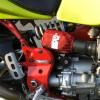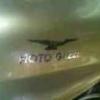-
Posts
2,378 -
Joined
-
Last visited
-
Days Won
62
Kiwi_Roy last won the day on June 19
Kiwi_Roy had the most liked content!
Profile Information
-
Location
Cell 401
-
My bike(s)
VII Sport & Griso long gone72 Eldorado, V7iii Special 76 Convert aka Magic Carpet Ride
Recent Profile Visitors
5,140 profile views
Kiwi_Roy's Achievements
-
Connect a small 12 Volt lamp between the starter solenoid trigger terminal and chassis, Does it turn on when you press Start? With the key turned On does the headlight turn On, it should then go Off when you press Start
-
Kiwi_Roy started following Battery Voltmeter , It will not Start , Low beam trouble… and 7 others
-
The Starter solenoid draws a lot of current 40 - 50 Amps so it will blow a 15 Amp fuse after a few seconds. Actually on most Guzzi's the solenoid current is limited by bad joints dirty contacts and wimpy wires.
-
Thats right the tiny ground wire will get red hot and weld itself to other wires in the loom This happens while cranking up to 150 Amps, there's a photo on here somewhere
-
The dimmer switch will drop the Voltage to the headlight by quite a bit. I usually add a relay or pair of relays in the headlight bucket If you use a form C relay powered up at the common terminal one filament on N/O one on N/C then you only need one signal from the dimmer switch The dimmer switch now has an easy life switching about 100 milliamps rather than 4-5 Amps There can be a considerable loss of Voltage between the headlight relay and the headlight bucket. I read somewhere that incandescent Lamp brightness is effected by voltage to the power of 5 Note Voltage drop in the headlight circuit also effects battery charging if you have a Ducati Energia regulator, it taps into the headlight feed after the relay up under the tank I'm talking early VII Sport.
-
This chart is enlightening I don't think Flooky told us what battery he has? Probably not an Odyssey i'm guessing. Isn't the normal battery Guzzi's come with a Yuasa, we need a decent chart similar to Odyssey's for that make. Roy
-
I like the switch feature, please attach a link to the Amazon advert. A Voltmeter is good for peace of mind, I bought a new V7 in 2017 with a short in the stator, struggled for weeks with weak charging before the stator was replaced under warranty but now with a Voltmeter I can relax. I have mine connected to the running light in the headlight bucket. On with the key.
-
I remember in early days with my VII Sport when the regulator failed flattening the battery, I went to a local electronics part shop where I purchased a potted bridge rectifier connected the two yellow wires to AC terminals negative to chassis and Positive to battery. Rode home keeping the revs low so it didn't cook the battery. https://www.amazon.ca/BOJACK-KBPC2504-Rectifier-Electronic-Silicon/dp/B07X8G6CPX/ref=asc_df_B07X8G6CPX These need to be bolted to a heat sink for cooling. Beats calling for a tow.
-
It sounds like time to purchase a new ignition switch, What is the mileage on the bike? Do the lights turn ON with the key? another possibility, use a 12 Volt relay connected to the good remaining contact to bypass the ignition switch. Shortly after buying a used VII Sport I had it splutter and die I suspected the ignition switch and found the contact resistance to be over 18 Ohms so I pulled the switch apart, the grease in the contacts was quite stiff holding the contacts apart, wiped it all out and replaced with fresh, soft, Vaseline This should be done every year or so. The Key mechanisms are sometimes very hard to remove, if so you can sometimes just unscrew the contact block. I wonder if you could just shim the lock barrel using shim stock? Sometimes the wires snap off where they are soldered to the switch the switch due to the constant flexing back and forth, the copper wires work harden and becomes brittle. Try to clamp the wires so they don't flex next to the solder joint. If you can re-locate the switch from the steering to the frame somewhere so there is no wire flexing that's an improvement.
-
You could swap the coils over but you have to swap the primary wires also If you measure the resistance from the plug cap to chassis it should be the same on both sides about 7000 Ohms from memory might be less if there's no suppressor resistor in line.
-
I would also check that you're not losing Voltage through a dirty ignition switch that happened to my VII Sport cleaning and re-lubing the switch fixed that.
-
To make your bike more visible to other road users consider adding a pair of LED driving lights I added a pair of these to my V7III Special $40 each https://www.superbrightleds.com/led-light-pod-2-modular-led-off-road-work-light-10w-900-lumens The nice thing about LEDs they normally give out full brightness from 9 Volts on up so you can lose a Volt you can't afford to lose with an incandescent lamp These lights come with an integral cable about a foot long so you may not need the optional wiring Harness.
-
- 3
-

-

-
Yes, make sure your main ground is good, typically it runs to a 6mm bolt at the rear of the gearbox The regulator also needs to be well grounded, i prefer that to be a short jumper to a timing cover screw rather than back to the battery. I think we figured that this picture was the result of a bad main ground,. On starting the starter current 100+ Amps tried to get back to the battery via the small wire between the regulator case and battery Negative the massive engine and gearbox castings are a better path than a wimpy copper wire. Better that the starter doesn't work than frying the loom.
-
CIty Light The small bulb in the headlight Park Light or any low load circuit that's on with the key
-
Its good to have a nice multimeter in the garage but at the price of these things why not have it on the bike 24/7 where you can see it while riding https://www.walmart.ca/en/ip/Digital-Voltmeter-Mini-LED-Round-Battery-Tester-12-Volt-24-Volt-Voltage-Meter-Waterproof-for-Car-Motorcycle-Boat-1-Piece-Red/61I6RYXP96V5 From this vendor the price is $25 but I have seen it several sites for $6 so shop around. I have one on my V7III connected across the city light, best mod ever. https://www.amazon.ca/Waterproof-Voltage-Digital-Voltmeter-Motorcycle/dp/B09MZHJQJX/ref=asc_df_B09MZHJQJX?th=1 They even ship it with a pair of spade connectors to wire it up fo $6 I prefer the blue colour LED over amber. The case is waterproof. When I turn the key On it shows 12.5 - 12.6, drops down to ~10.5 while cranking then jumps up to 13, will sometimes go as high as 14.2 while motoring at speed









